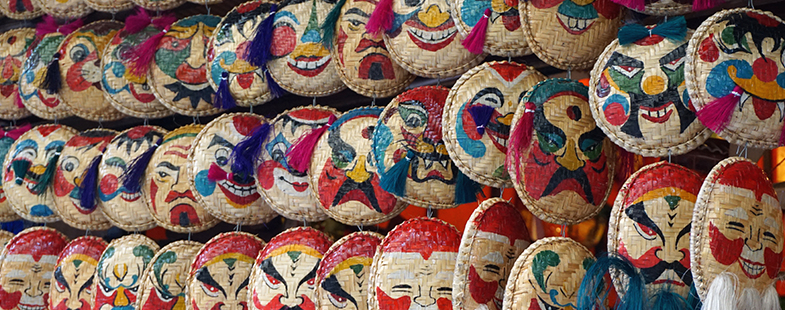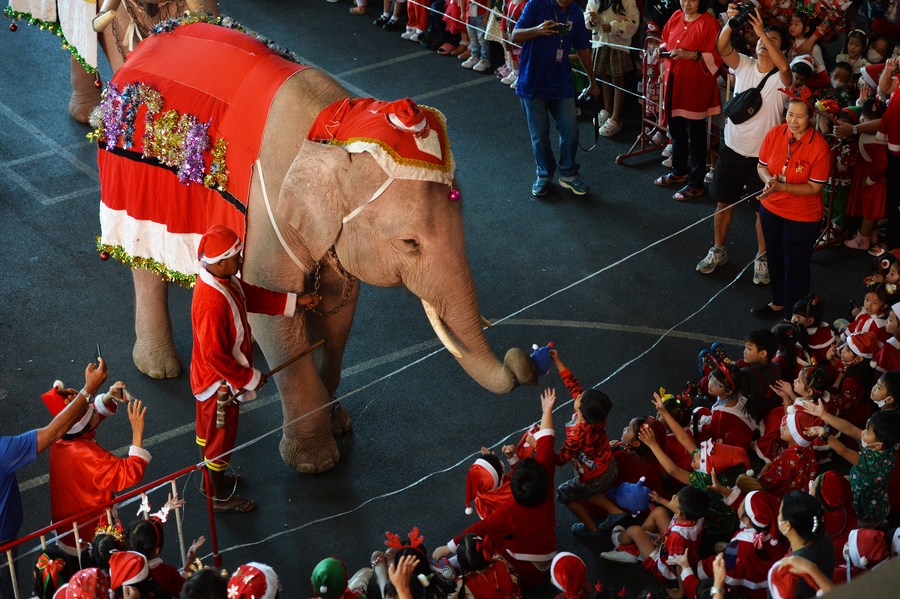Xam Singing – A Vietnamese Folk Art Form
Amongst the gallery of vibrant and unique art forms of Vietnam, there is one, with a humbling origin, that captured everyone's heart through its heartfelt lyrics and made its way to be one of the greatest traditional arts that still lives on to this day. In Vietnam, it is known as “Hat Xam", whereas “Hat" means singing, and “Xam” depicts its original performers.
I. Xam Singing – A Folklore
A captivating legend surrounds the birth of Xam singing. It tells the story of two princes, Tran Quoc Toan, and Tran Quoc Dinh, during the reign of King Tran Thanh Tong. According to the tale, Tran Quoc Toan, consumed by ambition, plotted against his brother, Tran Quoc Dinh, leaving him blind and abandoned in the wilderness. Devastated and alone, Tran Quoc Dinh found solace in music.
In a dream, a deity appeared to him, revealing the secrets of crafting a unique instrument. Upon waking, he built the instrument as instructed, and its enchanting melodies miraculously attracted birds who brought him food. Emerging from this hardship, Tran Quoc Dinh dedicated himself to teaching music to the poor and visually impaired.
While captivating, this story remains a work of fiction. Historical research suggests Xam singing arose much later, around the 14th-15th centuries (1500-1600 AD). Originally known as "hat rong" or "wandering singing," it was practiced by the poor and blind.
In a dream, a deity appeared to him, revealing the secrets of crafting a unique instrument. Upon waking, he built the instrument as instructed, and its enchanting melodies miraculously attracted birds who brought him food. Emerging from this hardship, Tran Quoc Dinh dedicated himself to teaching music to the poor and visually impaired.
While captivating, this story remains a work of fiction. Historical research suggests Xam singing arose much later, around the 14th-15th centuries (1500-1600 AD). Originally known as "hat rong" or "wandering singing," it was practiced by the poor and blind.
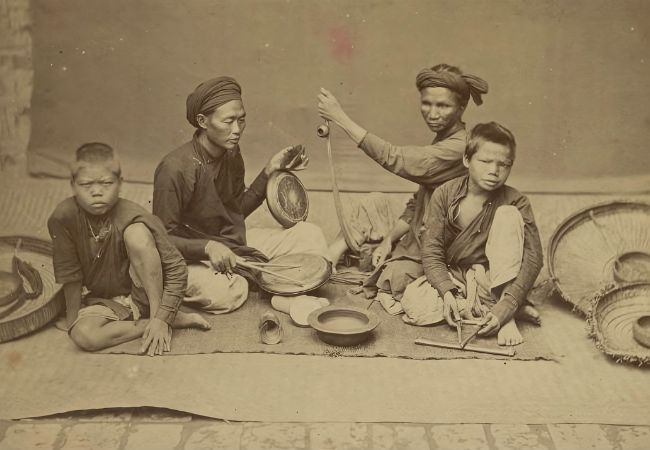
Xam has developed from "wandering singing" to Vietnam's treasured art form
II. An Art Form of the Blind
1. Xam Singing in the Past
The art of Xam singing originated from the ancient land of Linh Nam, which is the northern region of present-day Vietnam, and flourished from the 16th century. It is typically performed by Xam artists, a group of experienced individuals with high proficiency in both performing and composing Xam songs.
Xam singing is a popular folk music genre in the northern plains and highlands of North Vietnam. Back in time, Xam singing was often performed by visually impaired and impoverished artists who roamed from place to place, without homes, relying solely on their voices and instruments to earn a living.
Xam singing is a popular folk music genre in the northern plains and highlands of North Vietnam. Back in time, Xam singing was often performed by visually impaired and impoverished artists who roamed from place to place, without homes, relying solely on their voices and instruments to earn a living.
2. How Xam Singing Got Its Way to People’s Hearts
Xam performers weren't just singers; they poured their souls into their songs, often sharing stories of personal hardship. This raw emotion resonated deeply with listeners, fostering empathy and making Xam a captivating art form.
The melodies are accessible and the songs themselves are like mini-stories reflecting everyday life. Historically, Xam artists even turned news into songs, creating a rapid and engaging way to spread information. Xam singing has been recognized by UNESCO as an intangible cultural heritage of humanity that needs to be preserved.
The melodies are accessible and the songs themselves are like mini-stories reflecting everyday life. Historically, Xam artists even turned news into songs, creating a rapid and engaging way to spread information. Xam singing has been recognized by UNESCO as an intangible cultural heritage of humanity that needs to be preserved.
III. The Melodies of Xam Singing
1. Xam Cho Melody
Unlike some Xam melodies that evoke a sense of sorrow or hardship, the Xam Cho melody exudes a playful and lighthearted spirit. The use of uplifting notes and a faster tempo creates an atmosphere of cheerfulness and invites listeners to stop and enjoy the music. This approach serves two purposes: it attracts a crowd and sets a positive tone for potential customers who might be drawn to a vendor's stall by the lively sounds.
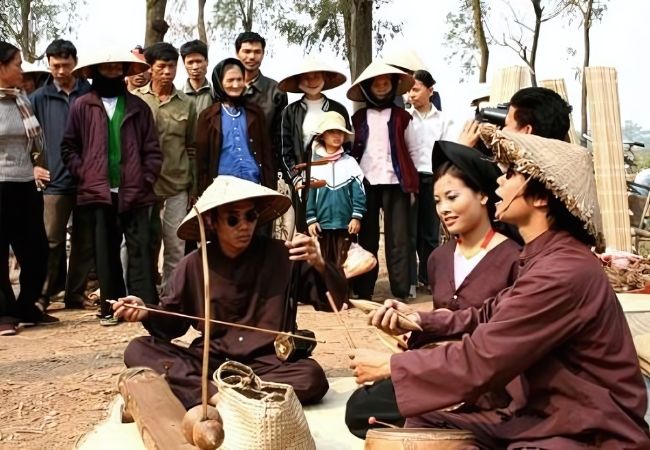
Xam Cho is performed at markets and attracts people with its uplifting melody
2. Thap An Melody
Known as Xam Thap An, it embodies the virtue of Filial Piety in society. It recounts the remembrance of 10 virtues of gratitude towards parents from childhood to adulthood. The distant sound of Thap An carries with it poignancy, rich emotions, easily touching the hearts of listeners.
3. Phon Hue Melody
In a society where women often lacked a platform to express their struggles, the Phon Hue melody became a voice for the voiceless. It highlights the unfair societal expectation that women shoulder the blame for the "bad habits" of their husbands. This could encompass anything from a husband's gambling addiction to infidelity. The melody serves as a social commentary, critiquing a system that placed the burden of blame on women even when the fault lay elsewhere.
4. Riem Hue Melody
One of the key themes explored through the Riem Hue melody is love. With its lively tempo and playful nature, Riem Hue songs could paint a picture of budding romance, the joys and challenges of married life, or even the pangs of unrequited love. The use of playful melodies and witty lyrics could create a sense of lightheartedness, perhaps depicting playful teasing between lovers.
5. Chenh Bong Melody
Chenh Bong lyrics likely revolved around the innocent flirtations and stolen glances between young lovers. The melody itself, with its upbeat tempo and playful flourishes, would mirror these budding romances. The singer's voice, likely youthful and energetic, would carry a hint of mischief, adding to the flirtatious atmosphere.
6. Four-seasons Chantey
The Four-Seasons Chantey, or Khoan Chantey, isn't just a song - it's a vibrant echo of Vietnamese agricultural life. Traditionally sung in groups by farmers during plowing, these rhythmic chants, with their unique melodies for each season, served to uplift spirits and unify the workers. As society changed and people migrated to cities, the Chantey wasn't left behind. Clever performing artists adapted the chants for urban audiences, likely adjusting melodies and lyrics to resonate with city dwellers.
7. Hat Ai Melody
Unlike its more celebratory counterparts, hat Ai casts a poignant light on the human experience, lamenting the hardships and suffering that life can bring. This melody often appears to be mournful, echoing the struggles of daily life, societal injustices, or the weight of personal loss. Often appearing as sections within Xam songs, hat Ai serves as a powerful reminder of life's challenges, adding depth and emotional resonance to these multifaceted performances.
IV. The Lyrics of Xam Singing
Xam singing is a blend of singing and storytelling, expressing personal narratives and prose. Xam songs are typically oral traditions without specific authors, focusing on themes that reflect the thoughts and aspirations of people, farmers, urban dwellers, and women in feudal society. Additionally, Xam songs also reflect personal views on society and the state during that period.
In addition to these themes, many Xam songs convey a spirit of optimism, beautiful love stories, and empathy for the lower classes, who always believe in a better life and appreciate their parent’s upbringing. During wartime, Xam also became a channel to boost national morale and rally support for the Party, the country, and the people.
The lyrics of Xam singing are deeply influenced by the system of folk poetry, proverbs, and folk songs of Northern Vietnam. Six-eight verse poems, adapted with the sound of the lute and rhythmic beats, are used as Xam singing lyrics. This art form emphasizes harmony and accessibility to all, aligning with the performers' talents.
Xam always delivers messages reflecting the times, much like an information channel through music.
In addition to these themes, many Xam songs convey a spirit of optimism, beautiful love stories, and empathy for the lower classes, who always believe in a better life and appreciate their parent’s upbringing. During wartime, Xam also became a channel to boost national morale and rally support for the Party, the country, and the people.
The lyrics of Xam singing are deeply influenced by the system of folk poetry, proverbs, and folk songs of Northern Vietnam. Six-eight verse poems, adapted with the sound of the lute and rhythmic beats, are used as Xam singing lyrics. This art form emphasizes harmony and accessibility to all, aligning with the performers' talents.
Xam always delivers messages reflecting the times, much like an information channel through music.
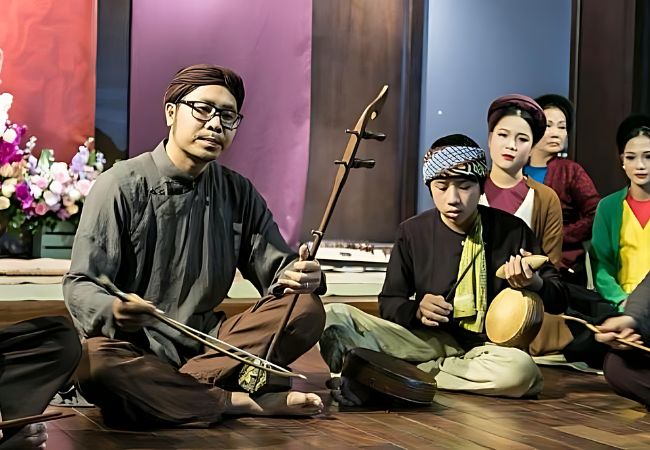
Xam Singing is loved by many
V. Xam Singing Instruments
The simplest ensemble for Xam singing typically includes just the đàn nhị (two-string fiddle) and the Sênh tiền (metal clappers). Larger Xam singing groups may incorporate additional instruments such as the đàn bầu (monochord), trống mảnh (small drum), and phách bàn (wooden clappers). Over time, and in response to the demand for larger ensembles, the variety of instruments used in Xam performances has expanded to offer more diverse musical arrangements.
1. Dan Nhi – Vietnamese 2-chord fiddle
The two-string fiddle, called the "đàn nhị," is a musical instrument with a slender body, as it has two strings, hence the name "đàn nhị." Its sound is clear, crisp, and soft, blending seamlessly with the high-pitched vocals.
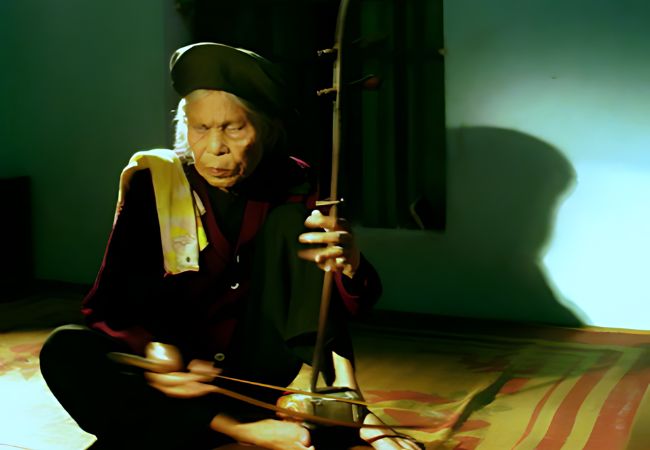
A Xam singer playing Dan Nhi
2. Senh – Hand Clappers
The accompaniment for Xam singing can come from either the "sênh sứa," consisting of two bamboo or wooden sticks, or the "sênh tiền," which features metal coins for a jingling effect. The "sênh tiền" consists of wooden clappers, with one end of the longer stick adorned with metal coins. It is primarily utilized to provide rhythmic beats in ceremonial music groups, court orchestras, and traditional dance performances.
On the other hand, the "sênh sứa" resembles two bamboo pieces shaped like leaves. Skilled performers manipulate the clappers with deft hand movements, alternating between opening and closing, vibrating their fingers, and exchanging hands. They tap the backs of the instruments together to produce rhythmic patterns and captivating sound effects. The "sênh sứa" is frequently employed in Xam music ensembles, complementing the resonance of bamboo castanets and contributing to the overall simple and harmonious ambiance.
On the other hand, the "sênh sứa" resembles two bamboo pieces shaped like leaves. Skilled performers manipulate the clappers with deft hand movements, alternating between opening and closing, vibrating their fingers, and exchanging hands. They tap the backs of the instruments together to produce rhythmic patterns and captivating sound effects. The "sênh sứa" is frequently employed in Xam music ensembles, complementing the resonance of bamboo castanets and contributing to the overall simple and harmonious ambiance.

To be able to control and play Senh sao requires a lot of practising
3. Trong manh – Drum
The "Trống mảnh," or Xam drum, is a traditional Vietnamese percussion instrument. It's struck with a drumstick to produce a deep, resonant sound. Its primary role is to maintain rhythm in Xam performances. Typically, a Xam performance starts with a drum solo, followed by the introduction of the two-string fiddle (đàn nhị), and then the clappers (phách).
4. Phach – Clappers
Phách has been integral to various musical genres and dances in Vietnam for centuries. In Xam singing, it's referred to as "cặp kè", which role is to maintain rhythm for the ensemble and the vocalist.
VI. Famous Xam Singers
1. Ha Thi Cau
Ha Thi Cau was the last Xam singing master of the 20th century in Yen Mo, Ninh Binh - the birthplace and heartland of this art form. With her melodies and voice, she became a living cultural treasure, representing the precious remnants of Xam art in the modern era.
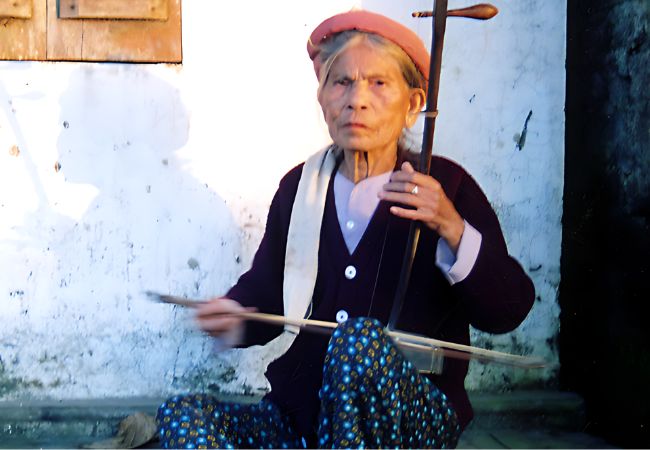
Ha Thi Cau became a living cultural treasure for her passion and talent in Xam singing
2. Artist Thanh Ngoan
Thanh Ngoan, a folk artist, has become a renowned figure in Xam singing worldwide with outstanding works such as "Sướng khổ vì chồng" (Joy and Suffering Because of Husband) and the Xam couplet "Thập ân" (Ten Duties). These Xam songs are filled with emotions and sentiments that have been highly praised not only domestically but also have attracted many audiences from Europe and the Americas.
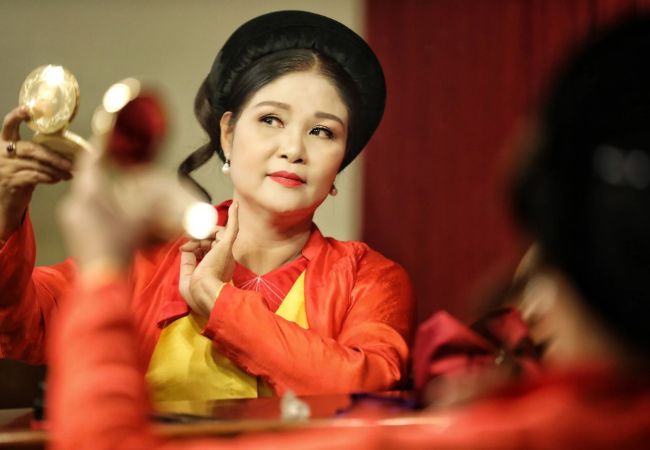
Artist Thanh Ngoan's Xam performances has reached many international audiences
VII. Preserving Xam Singing
Xam singing peaked in the late 18th and 19th centuries, where it was previously only a means of survival for many impoverished or disabled individuals. However, by the 20th century and during wartime, Xam art took a different trajectory. Organizations supporting the blind and the poor were established, and many Xam performers gradually faded away.
In January 2022, Xam singing was recognized as a national intangible cultural heritage to mark the achievements of the Department of Culture and Sports as well as of the artists passionate about this art form. Currently, Xam singing is performed in auditoriums, theaters, and stages, rather than in markets or on the streets as in ancient times.
Despite a long period of neglect, Xam art and many other forms of folk art have been revitalized. With a spirit of preserving the cultural beauty of the nation, the most refined values of Xam singing will continue to be passed down through time.
In January 2022, Xam singing was recognized as a national intangible cultural heritage to mark the achievements of the Department of Culture and Sports as well as of the artists passionate about this art form. Currently, Xam singing is performed in auditoriums, theaters, and stages, rather than in markets or on the streets as in ancient times.
Despite a long period of neglect, Xam art and many other forms of folk art have been revitalized. With a spirit of preserving the cultural beauty of the nation, the most refined values of Xam singing will continue to be passed down through time.
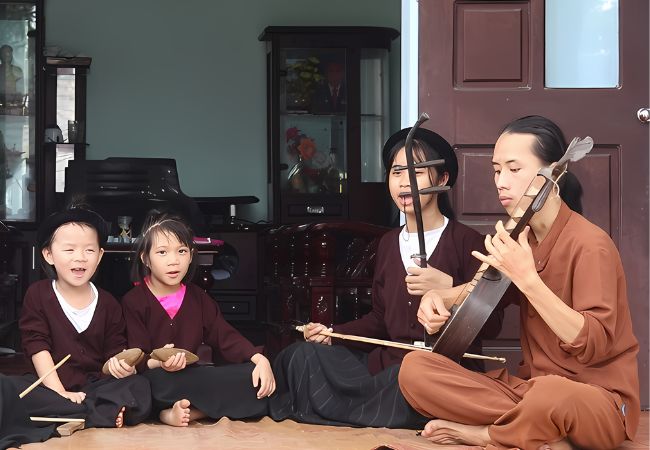
A Xam singing class to teach young generations
VIII. Where to See Xam Singing in Vietnam?
1. Hanoi's Old Quarter
For those intrigued by Vietnam's traditional arts, a stroll through Hanoi's Old Quarter on weekends is highly recommended. Along the way, you may chance upon a captivating Xam singing performance.
Since the pedestrianization of the area around Hoan Kiem Lake, both locals and visitors have eagerly anticipated the Xam shows at Nam Huong Communal House on Le Thai To Street, presented by the Xam Ha Thanh group. These performances, held every weekend night, offer a glimpse into the cultural richness of the city.
Another popular spot for hat Xam enthusiasts is the folk music stage in front of Dong Xuan Market, organized by the Vietnam Center for Musical Arts Development. You might also encounter impromptu performances on the streets of Ma May, Hang Ngang, or Hang Dao.
Since the pedestrianization of the area around Hoan Kiem Lake, both locals and visitors have eagerly anticipated the Xam shows at Nam Huong Communal House on Le Thai To Street, presented by the Xam Ha Thanh group. These performances, held every weekend night, offer a glimpse into the cultural richness of the city.
Another popular spot for hat Xam enthusiasts is the folk music stage in front of Dong Xuan Market, organized by the Vietnam Center for Musical Arts Development. You might also encounter impromptu performances on the streets of Ma May, Hang Ngang, or Hang Dao.
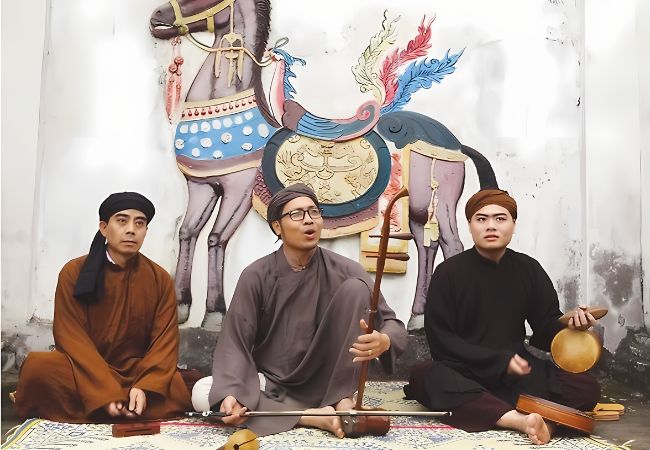
Xam singing can be found around the Old Quarter
2. Ninh Binh
Ninh Binh, a cradle of Xam singing art, is known for its association with the late artist Ha Thi Cau. To preserve this cherished tradition, Xam singing classes and clubs have been established. These classes and clubs aim to teach and share Xam singing with future generations and international tourists. During festivals in Ninh Binh, visitors can easily enjoy Xam singing performances in the ancient town of Hoa Lu or throughout Yen Mo province.
IX. Final Word
Xam singing, though facing challenges in the modern world, remains a captivating art form with a rich history and enduring legacy. Its diverse melodies paint a vivid picture of Vietnamese life. Whether sung by a lone artist or a group of farmers, Xam singing offers a window into the emotions, experiences, and societal critiques of a bygone era. By preserving and promoting Xam singing, we ensure that these stories continue to resonate, reminding us of the power of music to uplift, unite, and tell the stories of a culture.
Visit our website here for fascinating itineraries, travel tips, and tricks to plan your unforgettable Vietnamese adventure!
Visit our website here for fascinating itineraries, travel tips, and tricks to plan your unforgettable Vietnamese adventure!
